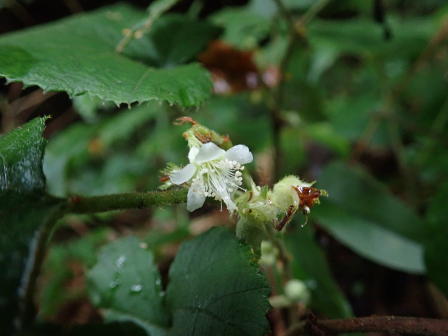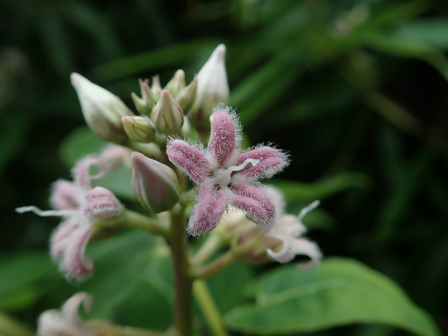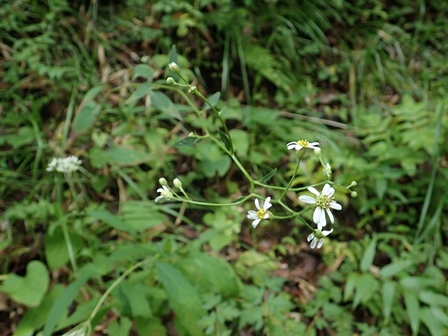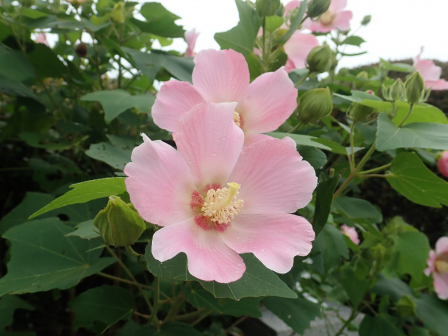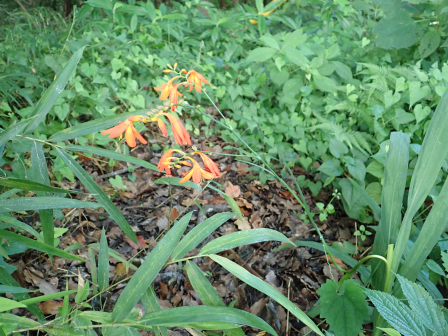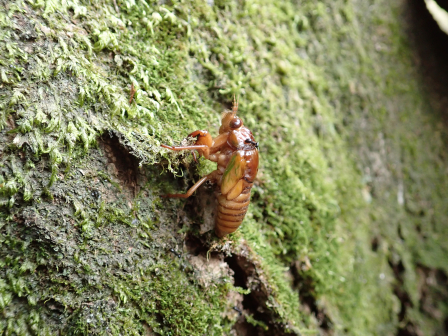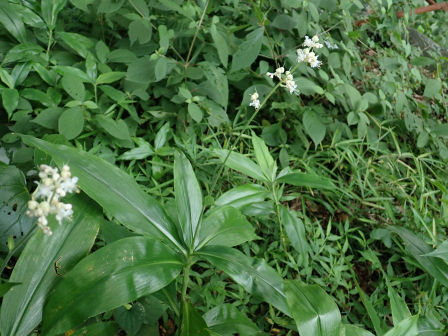フィールド日記
2021年08月
2021.08.31
フユイチゴ
裏道にフユイチゴが咲いていました。背丈が低く、草のようですが、木苺の仲間です。多くの木苺が春に花を咲かせ、初夏から夏にかけて果実をつけますが、フユイチゴはこの時期に花を咲かせ、冬に果実が熟します。果実は食用となります。(フユイチゴの果実のようすはこちら)
"Fuyu-Ichigo (フユイチゴ)" plants are in bloom on the back road. They are short and look like herbaceous plants but they are raspberries. Many other raspberries bloom in spring and bear their fruits in summer, but "Fuyu-Ichigo (フユイチゴ)" plants bloom now and bear their fruits in winter. Their fruits are edible. (Click here to read the article about an fruit of "Fuyu-Ichigo").
2021.08.27
ガガイモ
駐車場近くでガガイモが咲いています。花は星形で、花弁が反り返り、表面に白い軟毛が密に生えています。名前のイモは地下に芋があることを意味するのではなく、10㎝ほどになる大型の果実に由来します。
"Gaga-Imo" plants are in bloom near the parking area. The star-shaped flowers have reflexed petals on which soft white hairs grow densely. "Imo" in its name means "tuber", However, the name doesn't mean that they have tubers underground but that the name comes from their large fruits that grow up to 10 cm.
2021.08.24
シラヤマギク
校舎の裏でシラヤマギクが咲いています。山野に普通にみられる菊です。花は白い舌状花と黄色い筒状花からなりますが、舌状花はやや少なめで、疎らな印象を受けます。高さは150㎝ほどなります。
"Shira-Yama-Giku (シラヤマギク)" plants are in bloom behind the school building. They are a common species in fields and mountains. The flowers consist of white ray flowers and yellow disk flowers. There is a bit of space between petals of ray flowers, so the flowers seem to grow sparsely. They grow up to 150 cm in height.
2021.08.20
フヨウ
マリア様のご像の前のフヨウが咲いています。もともと中国語で芙蓉はハスを指しており、「ハスに似た花の咲く木」という意味でフヨウを木芙蓉と呼んでいたそうです。九州などに自生すると言われていますが、園芸植物として庭や公園に植栽されます。
"Fuyou (フヨウ)" trees are in bloom in front of the statue of Virgin Mary. The Japanese name comes from a Chinese name "芙蓉", which means lotus flowers. This species originally lived in the Kyushu region but now they are planted in gardens and parks as a gardening plant.
2021.08.17
コゲチャサビカミキリ
本館前のソテツでコゲチャサビカミキリを見つけました。もともとは南方系のカミキリムシだったようですが、現在は千葉県以西に見られる小型のカミキリムシです。
I found a longhorn beetle called "Kogecha-sabi-kamikiri" on Japanese sago palms in front of the main building. They are a small longhorn beetle which originally live in the southern area of Japan but now they are seen in the west of Chiba prefecture.
2021.08.13
クチバスズメ
蛍光灯の下でクチバスズメを見つけました。先日紹介した、モモスズメに似ていますが、より大型で、羽の模様が少し違います(モモスズメの記事はこちら)。和名は朽ち葉の意味で、羽の模様が枯れ葉のように見えることに由来するようです。
I found a "Kuchiba-Suzume (クチバスズメ)" moth under a fluorescent light. They are similar to "Momo-Suzume (モモスズメ)" moths I posted about the other day, but "Kuchiba-Suzume (クチバスズメ)" moths are lager and their patterns on wings are little different. Click here to read an article about the "Momo-Suzume (モモスズメ)" moths. The name comes from the fact that the colors and patterns on their wings look like dead leaves.
2021.08.10
ヒメヒオウギズイセン
校舎の裏でヒメヒオウギズイセンが咲いていました。南アフリカ原産の帰化植物です。日本へは、ヨーロッパで品種改良されたのち、130年以上前に移入されたようです。繁殖力が強く、各地で野生化した個体が見られます。
"Hime-Hiougizuisen (ヒメヒオウギズイセン)" plants are in bloom behind the school building. They originally came from South Africa. However, they were improved in Europe by breeding and then imported to Japan more than 130 years ago. They have high fertility so you can see them growing in the wild here and there in Japan.
2021.08.06
アブラゼミの幼虫
キャンプ場でアブラゼミの幼虫を見つけました。ちょうど地面から出てきたばかりのようで、木に向かって歩いていました。時間は17時前くらいでした。アブラゼミの幼虫は地中で4~6年ほど過ごしますが、成虫の寿命は数週間といわれています。
I found a larva of a cicada called "Abura-Zemi (アブラゼミ)" in the campsite. It seems that it just came out of the ground and was walking toward a tree. It was just before 5 p.m. Larvae of this species spend 4 to 6 years under the ground and then they live for only a few weeks above the ground as adults.
2021.08.03
ヤブミョウガ
校舎の裏でヤブミョウガが咲いています。和名は、葉がミョウガに似ていて、藪に生えることに由来しています。しかし、ヤブミョウガはツユクサ科、ミョウガはショウガ科なので、花の様子は異なります。(ミョウガの記事はこちら)
"Yabu-Myouga (ヤブミョウガ)" plants are in bloom behind the school building. The name "Yabu-Myouga (ヤブミョウガ)" comes from the fact that they grow in bushes and their leaves look like a plant called "Myouga (ミョウガ)". However, each plant belongs to a different family, so their flowers have different characteristics. (Click here to read the article about the "Myouga (ミョウガ)" plants.)
- 1 / 1


